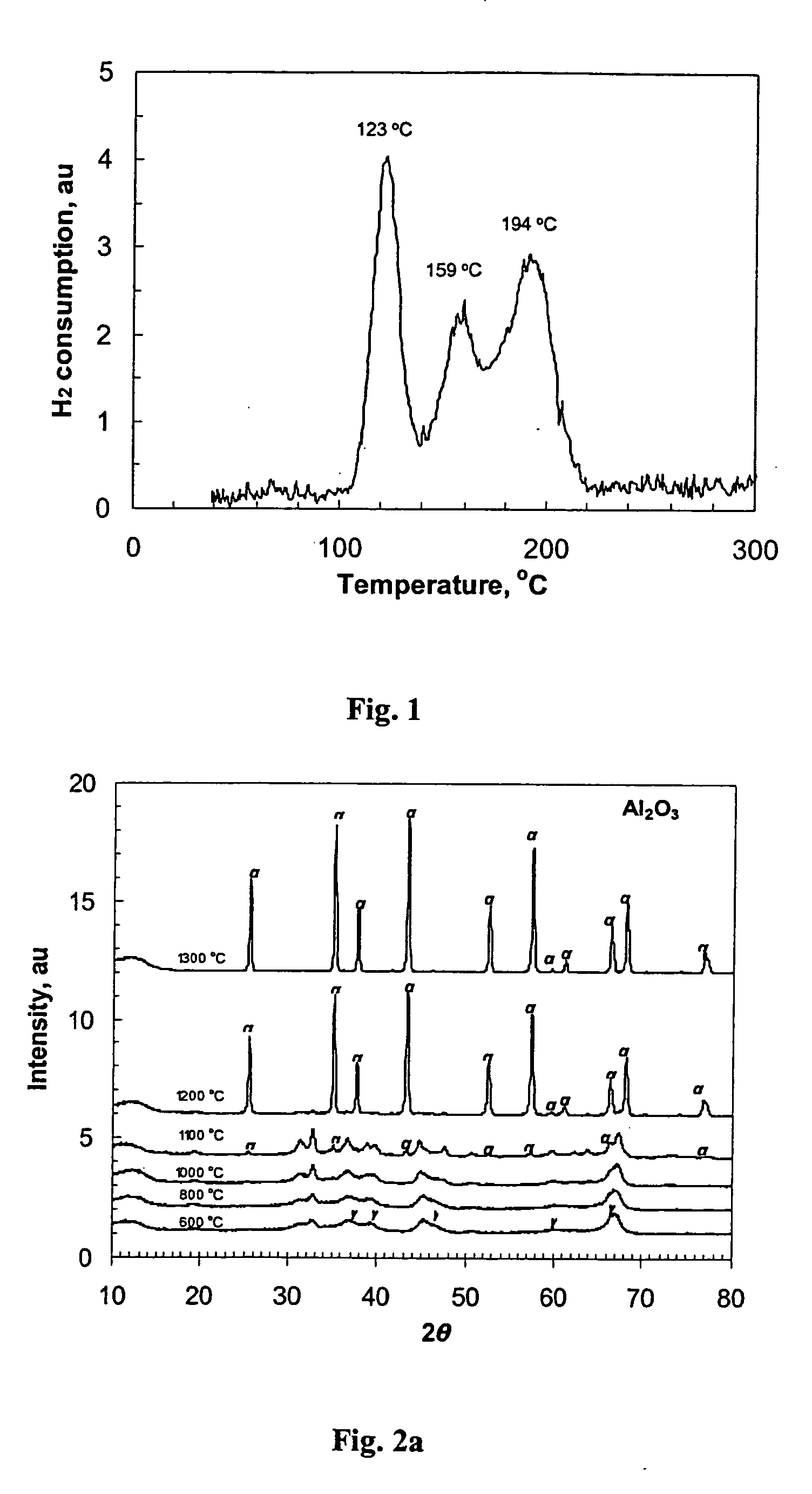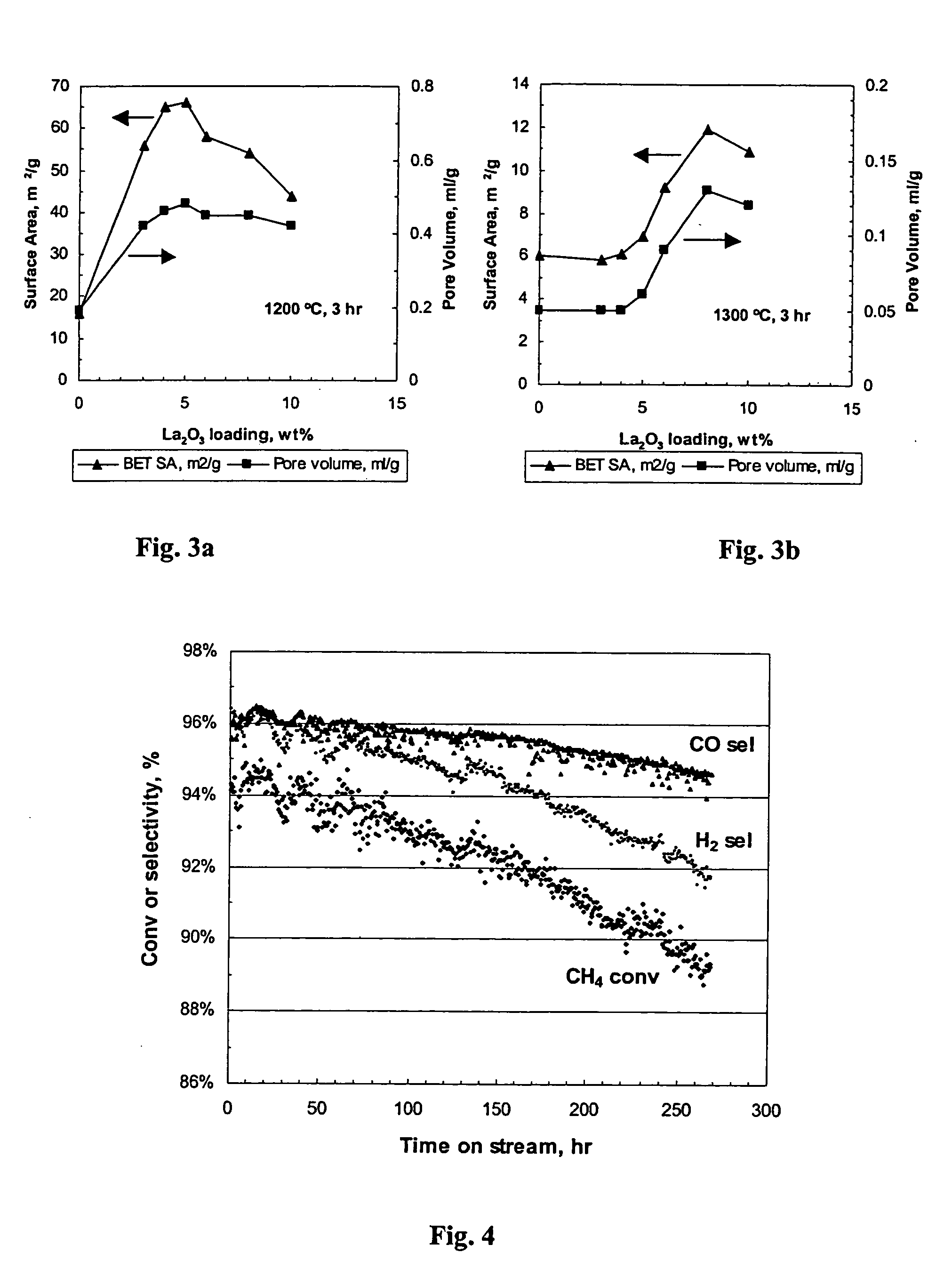Supports and catalysts comprising rare earth aluminates, and their use in partial oxidation
a technology of rare earth alumina and supports, which is applied in the direction of metal/metal-oxide/metal-hydroxide catalysts, physical/chemical process catalysts, bulk chemical production, etc., can solve the problems of slow and continuous loss of surface area, slow conversion to other polymorphs of alumina having much lower surface area, and collapse of the structure of the atoms, etc., to achieve high surface area aluminum-based supports
- Summary
- Abstract
- Description
- Claims
- Application Information
AI Technical Summary
Benefits of technology
Problems solved by technology
Method used
Image
Examples
examples
[0197] To improve the catalyst thermal stability, four catalysts Examples C1, C2, C3 and C4 were made without La (Examples C3 and C4) or with high loading of La (Examples C1 and C2) by calcining a gamma-alumina material at a high temperature of about 1,400° C.
Support Example S1 with High La Loading
[0198] Support preparation for catalyst Examples C1 and C2: An aluminum-containing precursor was obtained as gamma-Al2O3 spheres (#2750) from Davison with the following characteristics: a size in the range of 1.2 to 1.4 mm (average diameter of 1.3 mm.), a bulk density of 0.44 g / ml, a surface area and pore volume measure with N2 adsorption of 143 m2 / g and 0.75 ml / g respectively. For generating lanthanum-modified supports with a high lanthanum loading, Al2O3 spheres were impregnated with a lanthanum nitrate (La(NO3)3) solution, dried in an oven at 120° C. overnight, and then calcined in air with a temperature ramp of 1.5° C. / min until reaching a calcination temperature of about 1,400° C. a...
example c1
4%Rh / 25%La2O3—Al2O3
[0200] Catalyst preparation: The catalyst was prepared by the impregnation of Rh(NO3)3 solutions on the La2O3-modified Al2O3 support material obtained above (Example S1) to form a catalyst precursor, which was dried at 120° C. overnight and then calcined at 450° C. in air for 3 hours (the calcinations temperature was ramped at 1.5° C. / min). The calcined sample was reduced in 20% H2 / He with a temperature ramping rate of 1° C. / min to 400° C. and the temperature was held at 400° C. for 3 hours. The reduced catalyst was again heat-treated (second calcination) with a temperature ramping rate of 2.5° C. / min in flowing helium at about 1400° C. and held at this temperature for 3 hours (this step is called “post-reduction treatment”). The catalyst was then ready to be loaded into the reactor for testing. The Rh metal content in the catalyst was 4% by weight determined by mass balance.
example c2
2% Rh / 25%La2O3—Al2O3
[0201] The catalyst preparation procedure is similar to that of Example C1, except the amount of Rh(NO3)3 in the impregnating solution is such that the Rh content in the final catalyst was 2 wt % Rh instead of the loading of 4 wt % Rh in Example C1.
[0202] Table 5 lists the alumina phase content, the rare earth aluminate content (hexaaluminate-type), the lanthanum oxide (La2O3) content, BET surface areas, pore volume, total pore volume and average pore diameter. BET surface areas, pore volume, total pore volume and average pore diameter were measured by the BJH desorption method using N2 as the adsorptive of the modified alumina catalyst support, and the fresh catalysts made therefrom. The phase composition of the catalyst examples was done by Rietveld X-Ray Diffraction as described earlier.
Support Example S2 Without La Loading
[0203] Support preparation for Examples C3 and C4: the gamma-Al2O3 spheres from Davison as used for support Example S1 was calcined in ...
PUM
| Property | Measurement | Unit |
|---|---|---|
| pressure | aaaaa | aaaaa |
| temperature | aaaaa | aaaaa |
| temperature | aaaaa | aaaaa |
Abstract
Description
Claims
Application Information
 Login to View More
Login to View More - R&D
- Intellectual Property
- Life Sciences
- Materials
- Tech Scout
- Unparalleled Data Quality
- Higher Quality Content
- 60% Fewer Hallucinations
Browse by: Latest US Patents, China's latest patents, Technical Efficacy Thesaurus, Application Domain, Technology Topic, Popular Technical Reports.
© 2025 PatSnap. All rights reserved.Legal|Privacy policy|Modern Slavery Act Transparency Statement|Sitemap|About US| Contact US: help@patsnap.com



